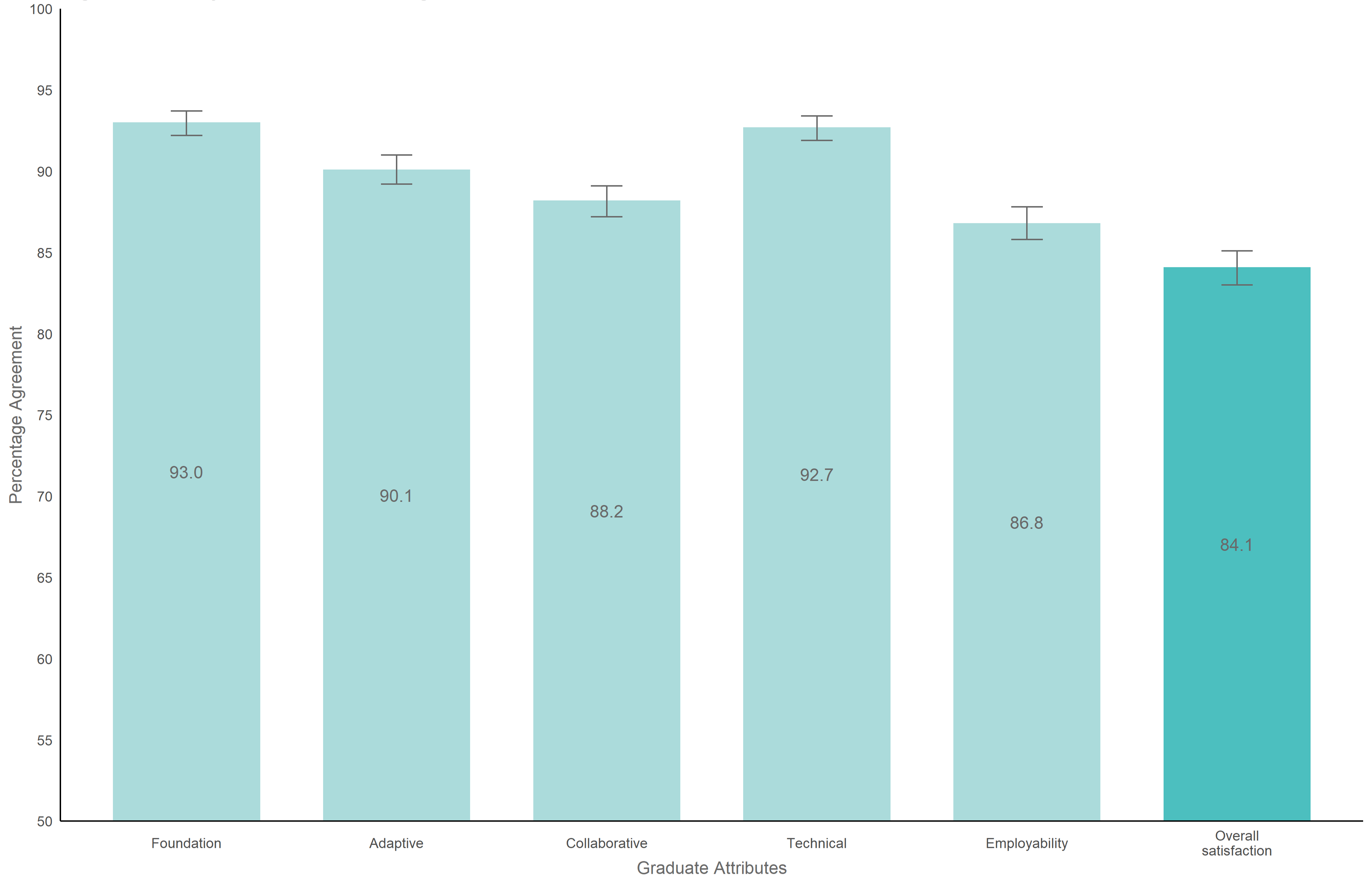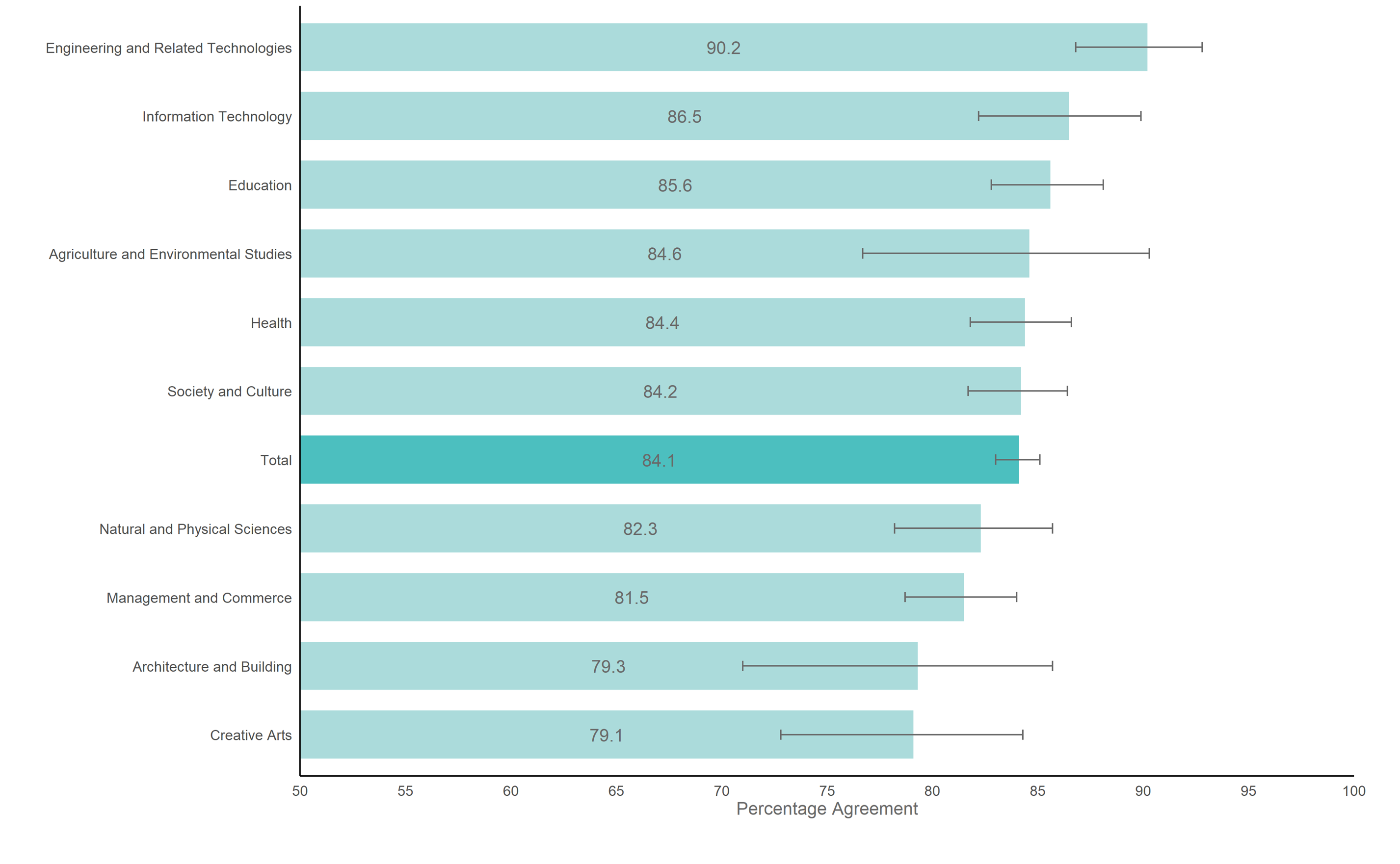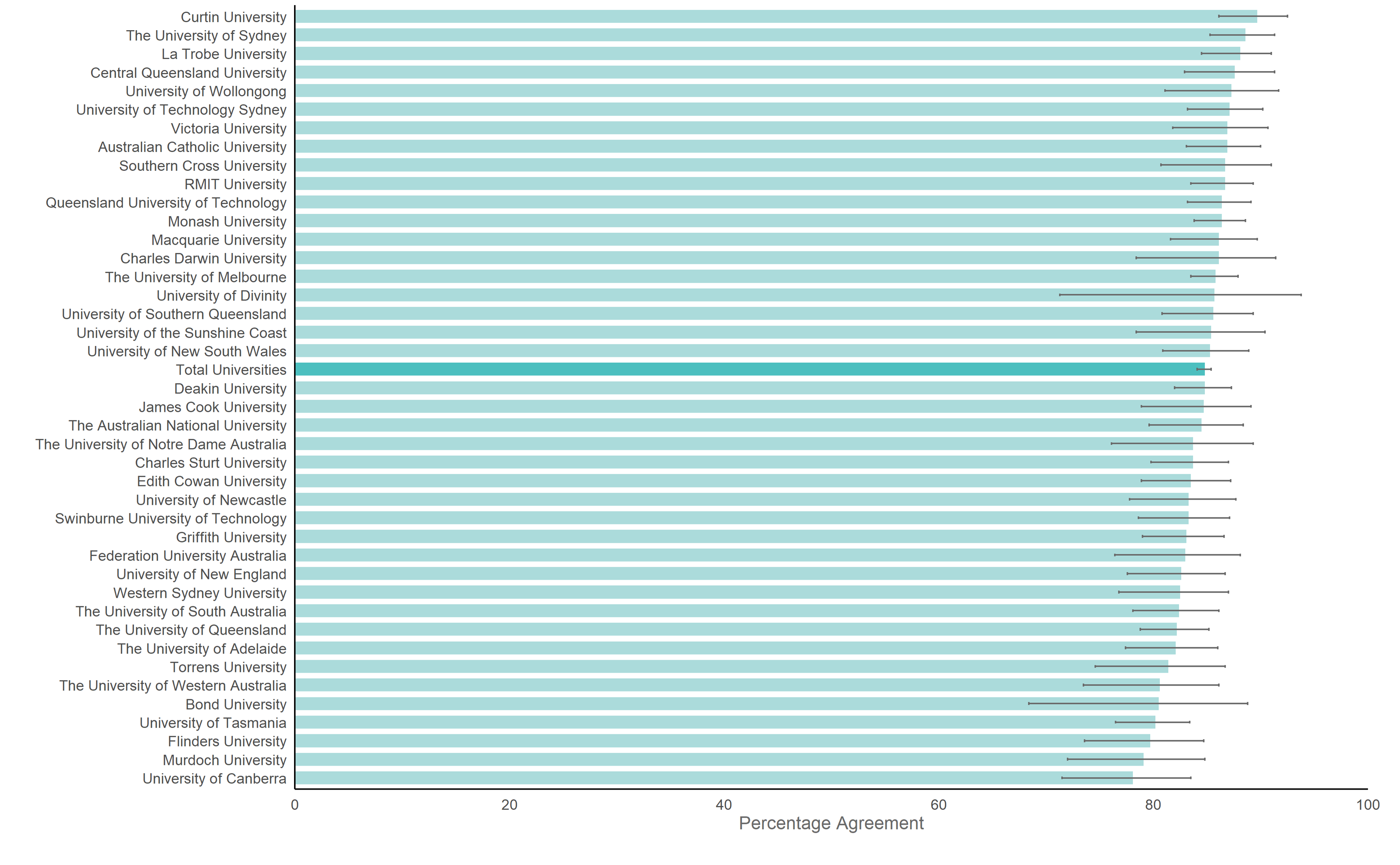2022 ESS Results
The 2022 ESS continues to demonstrate that Australia’s higher education graduates are rated highly by their direct supervisors, even during the period of significant labour market disruption associated with the COVID-19 pandemic. While direct supervisors’ overall satisfaction with higher education graduates decreased slightly between 2021 and 2022 (from 85.3 per cent to 84.1 per cent), the level of satisfaction remains high, within a tight range of 83.6 to 85.3 per cent since the inception of the ESS in 2016. A summary of the survey outcomes is provided below. Further details are available in the 2022 ESS National Report.
Employer satisfaction with graduate attributes and overall satisfaction, 2022 (%, with 90 per cent confidence intervals)

In 2022, employers reported the highest overall satisfaction with Engineering and Related Technologies graduates at 90.2 per cent. Supervisors also reported high levels of satisfaction with Information Technology graduates (86.5 per cent) and Education graduates (85.6 per cent). While still relatively high, employer satisfaction appears lower with Creative Arts graduates (79.1 per cent), Architecture and Building graduates (79.3 per cent) and Management and Commerce graduates (81.5 per cent).
Employer overall satisfaction by broad field of education, 2022 (%, with 90 per cent confidence intervals)

Employer satisfaction with graduate attributes and overall satisfaction, by broad field of education, 2022 (%, with 90 per cent confidence intervals)
| Foundation | Adaptive | Collaborative | Technical | Employability | Overall satisfaction | |
|---|---|---|---|---|---|---|
Natural and Physical Sciences | 94.3 (91.6, 96.2) | 92.4 (89.3, 94.7) | 90.2 (86.8, 92.8) | 95.9 (93.4, 97.6) | 89.4 (85.8, 92.1) | 82.3 (78.2, 85.7) |
Information Technology | 95.3 (92.2, 97.2) | 91.3 (87.4, 94.0) | 85.9 (81.5, 89.4) | 92.6 (89.0, 95.2) | 82.4 (77.5, 86.3) | 86.5 (82.2, 89.9) |
Engineering and Related Technologies | 95.7 (93.1, 97.3) | 88.8 (85.2, 91.6) | 93.4 (90.5, 95.5) | 95.5 (92.9, 97.2) | 91.4 (88.1, 93.8) | 90.2 (86.8, 92.8) |
Architecture and Building | 90.1 (83.2, 94.5) | 82.7 (74.7, 88.6) | 89.4 (82.5, 93.9) | 90.2 (83.4, 94.6) | 82.5 (74.4, 88.5) | 79.3 (71.0, 85.7) |
Agriculture and Environmental Studies | 96.1 (90.4, 98.7) | 96.2 (90.5, 98.7) | 91.1 (84.3, 95.3) | 96.2 (90.5, 98.7) | 92.2 (85.4, 96.1) | 84.6 (76.7, 90.3) |
Health | 90.2 (88.1, 92.1) | 88.4 (86.0, 90.4) | 86.1 (83.7, 88.3) | 91.9 (89.8, 93.5) | 83.4 (80.8, 85.8) | 84.4 (81.8, 86.6) |
Education | 91.4 (89.0, 93.3) | 91.0 (88.6, 92.9) | 85.0 (82.1, 87.5) | 92.6 (90.4, 94.4) | 87.5 (84.8, 89.8) | 85.6 (82.8, 88.1) |
Management and Commerce | 92.9 (90.9, 94.5) | 89.9 (87.6, 91.8) | 87.5 (85.0, 89.6) | 90.5 (88.2, 92.3) | 86.4 (83.9, 88.6) | 81.5 (78.7, 84.0) |
Society and Culture | 94.1 (92.4, 95.4) | 90.8 (88.8, 92.5) | 89.5 (87.4, 91.3) | 93.3 (91.5, 94.8) | 87.3 (85.0, 89.3) | 84.2 (81.7, 86.4) |
Creative Arts | 93.3 (88.7, 96.1) | 90.0 (84.7, 93.6) | 91.2 (86.3, 94.5) | 90.9 (85.9, 94.3) | 90.2 (85.0, 93.7) | 79.1 (72.8, 84.3) |
Total | 93.0 (92.2, 93.7) | 90.1 (89.2, 91.0) | 88.2 (87.2, 89.1) | 92.7 (91.9, 93.4) | 86.8 (85.8, 87.8) | 84.1 (83.0, 85.1) |
Employer satisfaction is consistently high across Australia’s Table A and B universities, with overall satisfaction ranging from 78.1 per cent to 89.7 per cent across universities, when results are combined from the 2020, 2021 and 2022 surveys. Employers rated graduates from Curtin University the highest at 89.7 per cent, followed by The University of Sydney (88.6 per cent) and La Trobe University (88.1 per cent).
Caution is warranted in interpreting differences in employer satisfaction across universities due to the relatively low number of survey responses at some universities.
Results for individual non-university higher education institutions (NUHEIs) are not published as the number of employer responses remains too low.
Employer overall satisfaction by institution, 2020 to 2022 (%, with 90 per cent confidence intervals)

Download the latest reports
About the ESS
The ESS provides information about the quality of education provided at Australian institutions, by asking supervisors to provide feedback about the generic skills, technical skills and work readiness of the graduate employed in their workplace. It is the first national survey that links the experiences of graduates to the views of their direct supervisors. The ESS is undertaken on a systematic basis by asking employed graduates who participated in the GOS to provide the contact details of their supervisor for follow up. The ESS has been conducted annually since 2016.
While there are an insufficient number of responses to publish institution by study area results on the ComparED website, the ESS is large enough to provide comparisons by broad field of education, course characteristics, employment characteristics, occupation and demographic group.
Results are pooled across the three most recent collection years to enable comparisons across universities. This follows the approach for other surveys on the ComparED website where results are pooled across years to improve the robustness and validity of data. The QILT reports and ComparED website do not publish results where there are fewer than 25 survey responses. For this reason, results for individual non-university higher education institutions (NUHEIs) are not shown as the number of employer responses is generally too small.
- Overall satisfaction
- Foundation skills - general literacy, numeracy and communication skills and the ability to investigate and integrate knowledge
- Adaptive skills - the ability to adapt and apply skills/knowledge and work independently
- Collaborative skills - teamwork and interpersonal skills
- Technical skills - application of professional and technical knowledge and standards
- Employability skills - the ability to perform and innovate in the workplace
Overall satisfaction
The percentage of supervisors who expressed overall satisfaction with their graduate.
Foundation skills
The percentage of supervisors who expressed satisfaction with graduates’ foundation skills.
Adaptive skills
The percentage of supervisors who expressed satisfaction with graduates’ adaptive skills.
Collaborative skills
The percentage of supervisors who expressed satisfaction with graduates’ collaborative skills.
Technical skills
The percentage of supervisors who expressed satisfaction with graduates’ technical skills.
Employability skills
The percentage of supervisors who expressed satisfaction with graduates’ employability skills.

